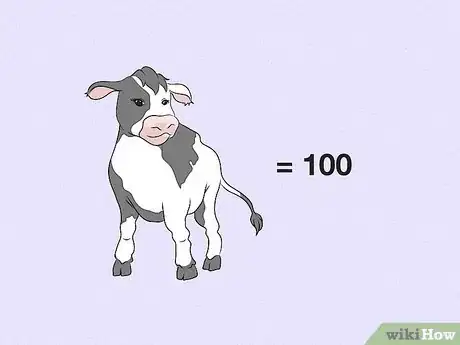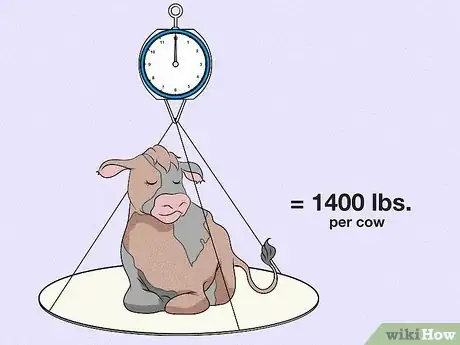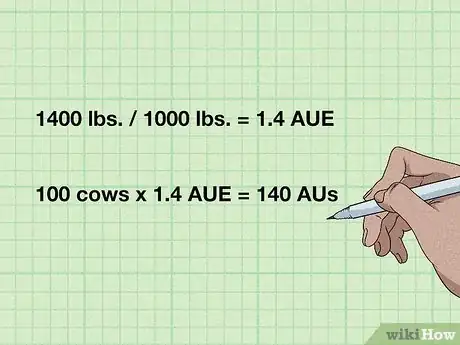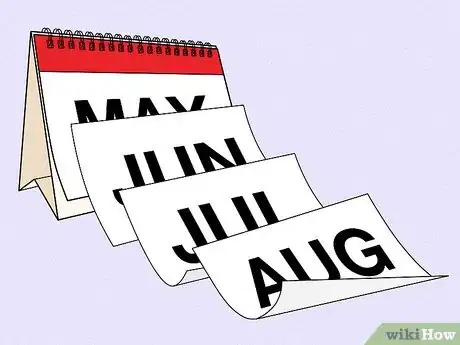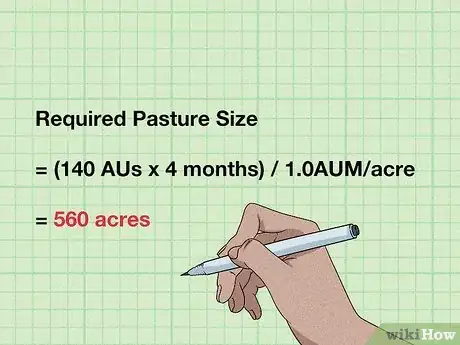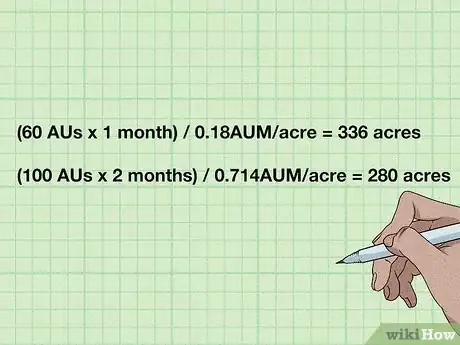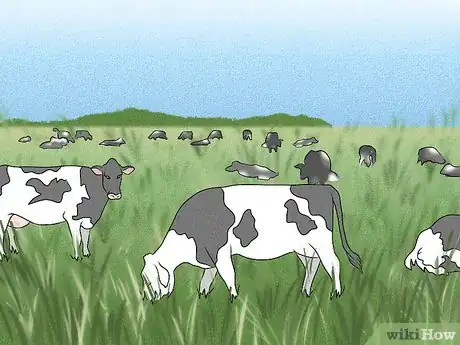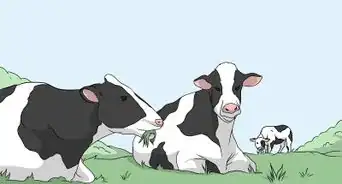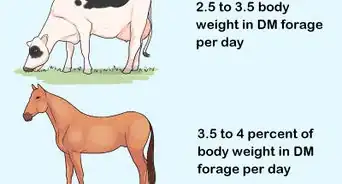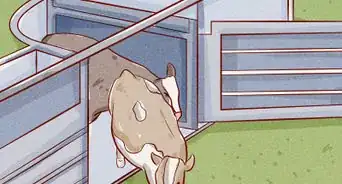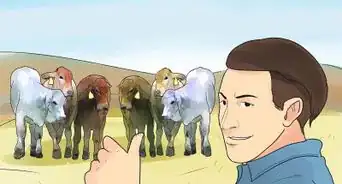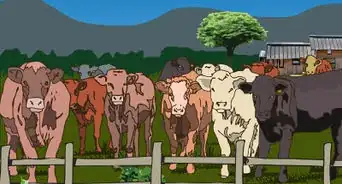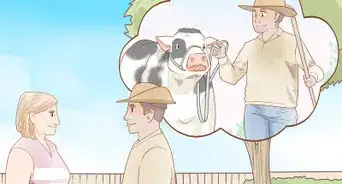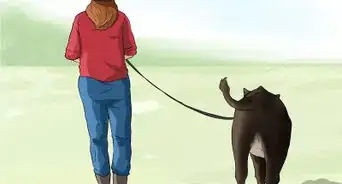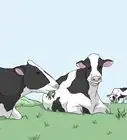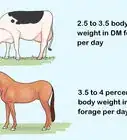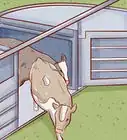This article was co-authored by Karin Lindquist. Karin Lindquist earned a BSc in Agriculture as an Animal Science major from the University of Alberta, Canada. She has over 20 years of experience working with cattle and crops. She's worked for a mixed-practice veterinarian, as a sales representative in a farm supply store, and as a research assistant doing rangeland, soil, and crop research. She currently works as a forage and beef agriculture extension specialist, advising farmers on a variety of issues relating to their cattle and the forages they grow and harvest.
There are 11 references cited in this article, which can be found at the bottom of the page.
This article has been viewed 432,817 times.
So, you have a certain number of animals to graze, but have no idea how much land you actually need. How can you figure that out?
That's where this article can help you out. Using the stocking rates for your area and the number of animals you have, among other things, you can figure out how much land you will need for your animals for the time allotted to graze them. An example will be used to better help you understand the calculations that are done to figure out the size of pasture needed for a group of animals.
Steps
-
1Figure the number of animals you wish to graze. This is one of the important factors that will affect the amount of land you need to graze your animals. For example, you may have 100 head of livestock to graze.
-
2Estimate the average weight of each of your animals. Another crucial piece to this puzzle is knowing how much your animals weigh. This can mean the difference between overgrazing your pastures and under-grazing them. Over-estimating the average size of your animals can be detrimental to your pastures. This is considered to be somewhat worse than under-estimating their weights. As will be discussed later, cow size has much to do with the standard metric used for calculating stocking rates. For the purpose of this article, let's assume you are grazing mature cows that average 1400 pounds per cow.[1]Advertisement
-
3Calculate the total number of animal units you have. The animal unit (AU) is the standard unit for stocking pastures. It is based on the amount that a cow or cow-calf pair will consume on a daily or monthly basis. The AU is based on the size of cows back in the early 20th century. Cows have gotten much bigger today. One Animal Unit (1 AU) is equal to one 1000 pound cow with or without a calf consuming about 25 pounds of forage per day (or ~800 pounds of forage per month).[2]
- To calculate the average animal unit equivalent (AUE) of your herd, divide the average weight of each of your cows by the Animal Unit weight. For example: 1400 pounds / 1000 pounds = 1.4 AUE (animal unit equivalent).[3]
- To calculate the total number of animal units you have, multiply the number of animals you have by the animal unit equivalent (see above). For example: 100 cows x 1.4 AUE = 140 AUs.
- Please note that an AUE (animal unit equivalent) is the adjustment calculated from the standard animal unit based on the average weight of each of your animals. AUEs can be used for any weight of any grazing animal, be they sheep, horses, bulls, goats, bison, elk, deer, weaned cattle, or llamas.
-
4Determine the stocking rate for your area.[4] Stocking rate is determined by the amount of forage growing in your pastures and the amount of that forage resource you wish your animals to consume. For more information on how to calculate stocking rates for your operation, please see How to Calculate Stocking Rates for Your Pastures.
- For this example, we will assume that you have a stocking rate of 1.0 AUM/acre.
-
5Determine the length of time you wish to graze that pasture for. This usually is measured by months, not days. For much of North America (not including the tropics or subtropics) a typical grazing season is between 4 to 6 months long. More southern grassland areas, like in California and down into Florida and Texas, are able to graze for 12 months long. Thus, let's assume you live an area where you will only graze these 100 cows for four months.[5]
-
6Put it all together to find how just how much space you need for your herd. Once you have figured out how many head of cattle you have, their weights and corresponding animal units, your stocking rate, and how long you intend to graze, you can plug them into a formula to get the amount of land needed for your herd.
- The formula is: Required Pasture Size = (Number of Animal Units x Length of Grazing Season) / Stocking Rate.[6]
- Using the example created: Required Pasture Size = (140 AUs x 4 months) / 1.0 AUM/acre = 560 acres.
- The formula is: Required Pasture Size = (Number of Animal Units x Length of Grazing Season) / Stocking Rate.[6]
-
7Find out if you can get the required space for your livestock. You may need to perform some recalculations if you cannot get the amount of acreage for your herd. This may involve either reducing the number of cows to graze, or the amount of time they should spend in the pasture.
- Do not change the weights of your cows in such recalculations! You will only end up getting yourself into a lot of trouble with the landholder if you deliberately under-estimate the weights of your cows, just so you can get as many in as possible. Not only could you seriously compromise the productivity of the land owner's pasture with potentially severe over-grazing, but you may also set yourself up to have your lease terminated earlier than what was agreed upon.
- Also do not change stocking rate unless you're absolutely sure that it should be changed. Always remember, the shorter the grasses look and the thinner the forage stand, the lower the stocking rate will be.
- If you reduce the number of cows you have or the time allowed to graze, you can reduce the amount of land needed to raise your animals on. For instance, 60 head of 1400-pound cows can be grazed on 336 acres of land. If you decided to graze your 100 head of 1400-pound cows for only 2 months, you could graze your cows on 280 acres.
-
8Turn your cows out to pasture and let them graze for the allotted time. Keep an eye on the pasture and the cows. If you find they are not getting enough, you may need to pull them out sooner than expected.
- These calculations are merely a guide and an estimation. They are not exact, nor ever will be. It's up to you, as manager, to pay attention to the resource (forage) the cows need in order to both keep your cows happy, and not cause significant damage to the land.
Community Q&A
-
QuestionWhat is the importance of stocking density?
 KarinTop AnswererStocking DENSITY (rather than stocking RATE) is much more time-flexible than stocking rate, because we can see how much live-weight per acre is on a piece of land for a set amount of time. To calculate stock density, an example: If we had 300 head of steers that weighed an average of 750 lb, total live-weight would be 225,000 lbs. If we put 300 head on 160 acres (a typical quarter section of land in Canada or the USA) using a paddock system of 0.5 acres (320 paddocks) then the calculated stocking rate is ((300*750)/0.5) = 450,000 lb/acre. This value is primarily used in a rotational grazing system, and can be taken further with regards to the time that this many animals are on that piece of land.
KarinTop AnswererStocking DENSITY (rather than stocking RATE) is much more time-flexible than stocking rate, because we can see how much live-weight per acre is on a piece of land for a set amount of time. To calculate stock density, an example: If we had 300 head of steers that weighed an average of 750 lb, total live-weight would be 225,000 lbs. If we put 300 head on 160 acres (a typical quarter section of land in Canada or the USA) using a paddock system of 0.5 acres (320 paddocks) then the calculated stocking rate is ((300*750)/0.5) = 450,000 lb/acre. This value is primarily used in a rotational grazing system, and can be taken further with regards to the time that this many animals are on that piece of land. -
QuestionWhy would undergrazing be harmful to pastures?
 Community AnswerIt has all to do with litter content. When grass plants die, they create a mat of dead plant material known as "trash" or "litter." Too much litter repels water, drying out the soil; it also reduces soil temperature and prevents sunlight from reaching the soil surface. This can reduce biodiversity in the stand. Biodiversity is also reduced when dominant grasses are not grazed heavily enough to reduce their competitiveness with lesser-competitive plant species. Lastly, soil microbial populations reduce in population size and/or go dormant because soil is too cool.
Community AnswerIt has all to do with litter content. When grass plants die, they create a mat of dead plant material known as "trash" or "litter." Too much litter repels water, drying out the soil; it also reduces soil temperature and prevents sunlight from reaching the soil surface. This can reduce biodiversity in the stand. Biodiversity is also reduced when dominant grasses are not grazed heavily enough to reduce their competitiveness with lesser-competitive plant species. Lastly, soil microbial populations reduce in population size and/or go dormant because soil is too cool. -
QuestionBallpark figure for how many cattle on four acres of land?
 Community AnswerFour cattle, and that's only for a month or two at best. To keep an animal an entire year, you're better off with a ballpark figure of one head per four acres.
Community AnswerFour cattle, and that's only for a month or two at best. To keep an animal an entire year, you're better off with a ballpark figure of one head per four acres.
Warnings
- Overgrazing is a real threat, and can be detrimental not only to the landscape, but to your animals too. Allowing your animals too long on a piece of land can reduce the amount of forage available next year without adequate rest and recovery.⧼thumbs_response⧽
- Pasture conditions change all the time, just like environmental conditions do. They may change for the worse or for the better, so be prepared to de-stock (or re-stock) if need-be to keep pastures in good shape.
- If feel you have to pull all your cows out of a pasture, then do so because it will be easier on the land when you come back to it in a better year.
⧼thumbs_response⧽ - Stocking rate calculations and calculations like that made above are mere estimates and guidelines, they are by no means accurate nor never changing. Take these with a grain of salt and make sure you monitor your cows and the forage that they are eating regularly.⧼thumbs_response⧽
References
- ↑ http://www.fao.org/3/s4314e/s4314e09.htm
- ↑ https://www.ag.ndsu.edu/archive/streeter/2006report/aums/Doing%20the%20Math.htm
- ↑ https://www.dairynz.co.nz/feed/pasture-management/assessing-and-allocating-pasture/pasture-assessment/comparative-stocking-rate/
- ↑ https://extension.usu.edu/rangelands/ou-files/Determine_Stocking_rate.pdf
- ↑ https://extension.wsu.edu/animalag/content/the-abcs-of-pasture-grazing/
- ↑ http://factsheets.okstate.edu/documents/pss-2871-stocking-rate-the-key-to-successful-livestock-production/
- ↑ http://extensionpublications.unl.edu/assets/pdf/g2212.pdf
- ↑ https://pasturemap.com/pasture-inventory-estimate-available-dry-matter/
- https://digitalcommons.usu.edu/cgi/viewcontent.cgi?referer=&httpsredir=1&article=1992&context=extension_histall
